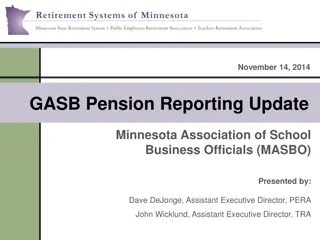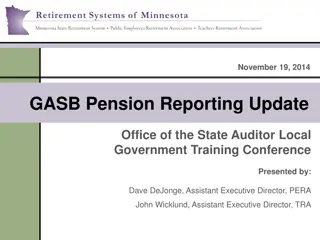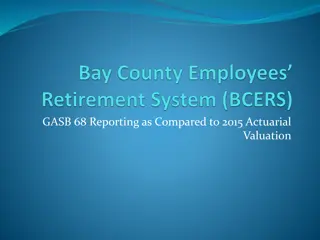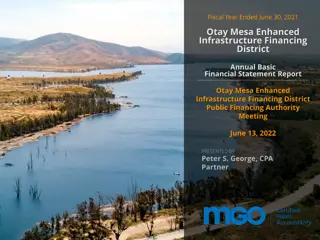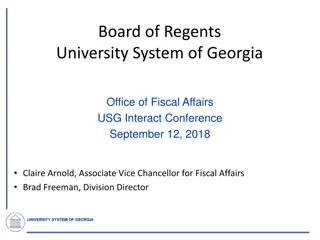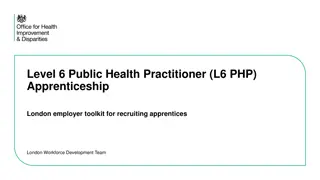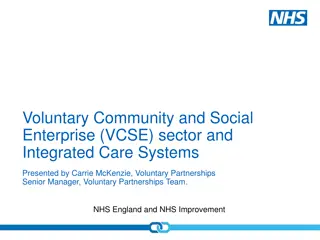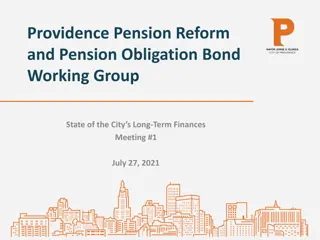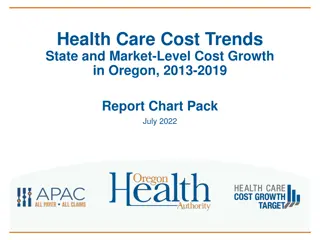Understanding GASB OPEB Changes in Public Sector Health Care Benefits
GASB has introduced new standards for OPEB plans, similar to GASB 67/68 for pensions. The changes impact reporting and liabilities, requiring a blended discount rate and Entry Age Normal method. Employers must now carry the Net OPEB Liability on their balance sheets and provide extensive disclosures. Timing and effective dates for implementation are crucial aspects discussed in this overview.
Download Presentation

Please find below an Image/Link to download the presentation.
The content on the website is provided AS IS for your information and personal use only. It may not be sold, licensed, or shared on other websites without obtaining consent from the author. Download presentation by click this link. If you encounter any issues during the download, it is possible that the publisher has removed the file from their server.
E N D
Presentation Transcript
Cavanaugh Macdonald C O N S U L T I N G, L L C The experience and dedication you deserve GASB s OPEB Changes - Will they impact public sector health care benefits? November 7, 2014 Eric Gary, FSA, FCA, MAAA Chief Health Actuary
Agenda Background How is it like GASB 67/68? How is it different from GASB 67/68? 2
Timing Exposure drafts released on 5/28/2014. Comment deadline was 8/29/2014. Public hearings held in September 2014. Target date for final statements is June 2015. Proposed effective dates: Plans: Fiscal years on or after 12/15/2015 Employers: Fiscal years on or after 12/15/2016 3
New GASB Standards for OPEB Plans Project No. 34-1P: Financial Reporting for Postemployment Benefit Plans Other Than Pension Plans Employers Project No. 34-1E: Accounting and Financial Reporting for Postemployment Benefits Other Than Pensions Very similar to GASB 67/68 pension changes 4
Similar to GASB 67/68 Net OPEB Liability (NOL) moves to balance sheet of employers. NOL is: Actuarial accrued liability (referred to in statements as Total OPEB Liability or TOL) based on Entry Age Normal funding method, less Plan s Fiduciary Net Position (market value of assets). Discount rate is a blended single rate that is the equivalent of the long-term rate while assets are available and a municipal bond index for the remaining period. Many OPEB plans already using a blended rate, although more loosely defined. 5
Similar to GASB 67/68 Entry Age Normal (EAN) level percent of pay cost method. Method said to be chosen to enhance comparability. OPEB Expense EAN normal cost Interest on the NOL Immediate recognition of changes in active and inactive liability due to plan amendments Deferred recognition (over average remaining service life) of changes in active and inactive liability due to assumption changes and actual experience Deferred recognition of investment gains and losses over five years Deferred inflows/outflows 6
Similar to GASB 67/68 Cost sharing employers will need to report proportionate share of NOL, OPEB expense and deferred inflows and outflows. Must account for special funding situations when a non-employer contributing entity is present. Extensive footnote disclosure and supplementary information required. 10-year schedules of many items. 7
OPEB-Specific Items Costs Changes consistent with recent changes to actuarial standards of practice (ASOPs) Dropped GASB 43/45 s reference to community rated cost basis. Reference to include certain taxes (e.g., PPACA s High Cost Plan Excise Tax or Cadillac Tax ). ASOP No. 6: Measuring Retiree Group Benefits Obligations and Determining Retiree Group Benefits Program Periodic Costs or Actuarially Determined Contributions Provides guidance for coordinating and integrating all of the elements of an actuarial valuation of a retiree group benefits program. Effective for any actuarial work product with a measurement date on or after March 31, 2015. 8
OPEB-Specific Items Claims costs Pooled Health Plans The actuary should reflect the full age-specific cost, including the implicit subsidy. The value of the employer s benefit commitment is independent of the method used to provide the benefit. Results in a more appropriate representation of the employer s long-term liabilities for retirees as there is no guarantee that the current premium structure or the pooled health plan will continue over the long-term nor that the employer will continue or be allowed to continue in the pool. The actuary should use age-specific costs based upon the pooled health plan s total age distribution and the pooled health plan s total expected claims costs. Distribution table for the total number of covered health plan members by age, or by age and gender, provided by the pooled health plan. If pooled health plan information is not available, the actuary may make a reasonable assumption regarding the pooled health plan s age/gender distribution. 9
OPEB-Specific Items Claims costs Cadillac Tax Projected benefit payments also should include taxes or other assessments expected to be imposed on benefit payments Impact to long-term trend assumption 100% 90% 80% 70% 60% 50% 40% 30% 20% 10% 0% 2018 2034 2050 2066 2014 2022 2026 2030 2038 2042 2046 2054 2058 2062 2070 2074 2078 2082 2086 2090 2094 2098 2102 2106 2110 2114 2118 2122 2126 2130 Total Budget @ 3% Inflation Other @ 3% Inflation Health Care @ 5% Inflation 10
OPEB-Specific Items Claims costs Subsidies [P]rojected benefit payments should not be reduced by subsidies expected to be received for making benefit payments other than those received for providing Medicare benefits. Technical Bulletin No. 2006-1 still applies. 11
OPEB-Specific Items Discount Rate Pay-as-you-go: Index rate for high-quality 20-year tax exempt bond (AA/Aa or higher). Generally speaking, OPEB plans are not as well funded. Potential volatility in discount rate assumption. Bond Buyer 20-Bond GO Index 6.00% 5.00% 4.00% Yield 3.00% 2.00% 1.00% 0.00% 12/1/2013 12/1/2004 6/1/2005 12/1/2005 6/1/2006 12/1/2006 6/1/2007 12/1/2007 6/1/2008 12/1/2008 6/1/2009 12/1/2009 6/1/2010 12/1/2010 6/1/2011 12/1/2011 6/1/2012 12/1/2012 6/1/2013 6/1/2014 Date 12
OPEB-Specific Items Discount Rate Experience study needed, if funded. Disclosures Long-term expected real rate of return for each major asset class. Money-weighted returns. 13
OPEB-Specific Items Sensitivity disclosures +/- 1% discount rate +/- 1% health trend Total of 9 NOL measurements. Rate of Investment Return +1% 0% -1% 1 2 +1% 3 Trend 4 6 0% 5 8 9 -1% 7 14
OPEB-Specific Items Entry age actuarial cost method (level % of pay) OPEBs are often not salary-based Payroll data Availability Comparability to pension data Volunteer plans Projections back to entry age Salary Benefits Negative normal costs Disability plans 15
OPEB-Specific Items Valuations required every two years. GASB 43/45 allows three-year valuation cycle if fewer than 200 participants. Alternative Measurement Method (AMM) is still an option. Less than 100 plan members (actives and retirees). Special footnote requirements. Model inputs more formulaic. Turnover should be derived from U.S. Office of Personnel Management data of the employee group covered by the Federal Employees Retirement System. 16
Stay In Touch GASB website www.GASB.org Live Meeting Webcasts GASB Board meetings available via live video/audio. Next meeting is November 11, 2014. 17
Questions? 18




